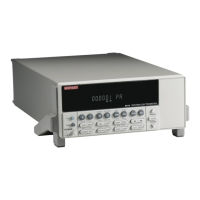4-12 Amps Measurements
Source capacitance
DUT source capacitance will also affect the noise performance of the Model 6514 ammeter.
In general, as source capacitance increases, the noise also increases. To see how changes in
source capacitance can affect noise gain, again refer to the simplified ammeter model in Figure
4-5. The elements of interest for this discussion are the capacitance, C
S
and the feedback capac-
itance C
F
. Taking into account the capacitive reactance of these two elements, the previous noise
gain formula must be modified as follows:
Here, Z
F
represents the feedback impedance made up of C
F
and R
F
, while Z
S
is the source
impedance formed by R
S
and C
S
. Furthermore,
and,
Note that as C
S
increases in value, Z
S
decreases in value, thereby increasing the noise gain.
Again, at the point where Z
S
= Z
F
, the input noise is amplified by a factor of two.
The maximum value of source capacitance (C
S
) for Model 6514 ammeter is 10,000pF. You
can, however, usually measure at higher source capacitance values by inserting a resistor in
series with the ammeter input, but remember that any series resistance will increase the voltage
burden by a factor of I
IN
R
SERIES
. For example, the range of resistance listed in Table 4-2 will
result in voltage burden values in range of 1mV to 1V. A useful alternative to a series resistor is
a series diode, or two diodes in parallel back-to-back. The diodes can be small-signal types and
should be in a light-tight enclosure.
Output V
NOISE
Input V
NOISE
1Z
F
/Z
S
+()=
Z
F
R
F
2πfR
F
C
F
()
2
1+[]
-------------------------------------------------=
Z
S
R
S
2πfR
S
C
S
()
2
1+[]
-------------------------------------------------=

